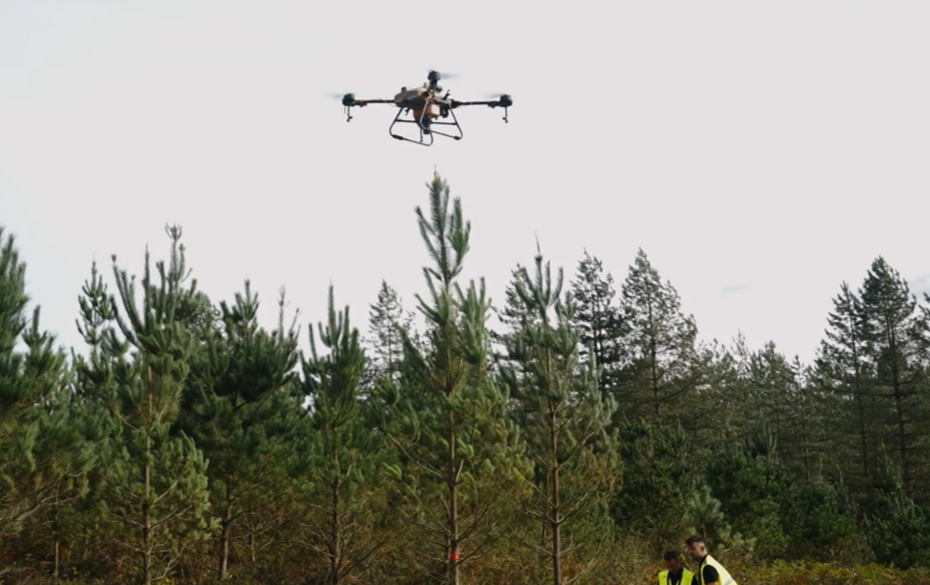NEW
Drones to protect forests from pests
27 March 2023- NEIKER has participated in the pioneering G.O. PhytoDron project that seeks to promote the use of drones in precision agriculture to preserve plant health in crops
- It is the only project at European level that has carried out trials with this tool on pine trees, research carried out together with BASKEGUR in a privately owned plot located in Aramaio (Álava, Basque Country)
Thanks to the GO Phytodron project, we are closer to making the use of drones in precision agriculture a reality and their use in pine trees in cases of urgency and under the premises of precision applications, complying with the strictest standards of sustainable and respectful management with the environment and people, both applicators and bystanders.
The application of phytosanitary products by drone is considered as the best available tool to contain the increasingly frequent threats of pests in the cultivated forest masses in Europe. Forest stands, as is the case in the Basque Country, with steep slopes and difficult access to specific areas, which require rapid, precise and localized intervention.
According to current regulations, unmanned aircraft -commonly known as drones-, are considered aerial treatment and this category is expressly prohibited unless expressly authorized. However, their characteristics to perform these applications make them a unique tool since the drift patterns of drones (a crucial parameter for their approval) do not resemble either aerial or conventional ground treatments. This is the reason why the new European regulations, now in draft phase, contemplate it as an aerial tool but with very valuable singularities for precision applications.
In this context, NEIKER, member of the Basque Research and Technology Alliance (BRTA), has been part of the G.O. PhytoDron project, together with Baskegur, the Basque Timber Association, with the aim of incorporating the use of drones in precision agriculture to improve productivity and, in turn, to advance in its regulatory framework, establishing possible scenarios for its use.
This initiative, which began in March 2021 and has just ended, has focused on testing the effectiveness and safety of drones when applying phytosanitary products in different crops such as pine trees, fruit trees, rice fields and vineyards.
Specifically, the technology center has been responsible for conducting the tests on radiata pine, one of the most widespread tree species in the Basque Country, in a plot located in Aramaio (Alava). Within the research it has been possible to observe the amount of product applied outside the treated area and the homogeneity of the pesticide in the pine trees, as well as the penetration of the product in the tree compared to other aerial and terrestrial tools.
Results and lessons learned
The G.O. PhytoDron project has yielded results and lessons to be further investigated in the future:
- Drifts: we have confirmed that the drift curves – displacements due to the air of a product, outside the determined target – with drones do not coincide with the curves of aerial and terrestrial applications. In other words, drifts with drones have their own performance. This implies that it is necessary to increase the database of drone applications to determine when and how to use this tool.
- Greater protection due to the screen effect: leafy trees, such as pine trees, exert a screen effect and, at the flight altitude at which they are applied with drones, they minimize the amount of phytosanitary products outside the area treated with drones.
- Greater precision and less product quantity: aerial drift or drift in height at 5 meters from the application area is null and there is never any product above the application height. In addition, drones allow directing the application using much smaller quantities than a terrestrial or even an aerial application. This opens a great opportunity for precise and localized forestry treatments.
- ‘Safer applications’: in drone applications, soil contamination between pine trees is much lower compared to applications with authorized terrestrial equipment. The drone is more accurate in reducing soil contamination.
- Specific training: it is necessary to know perfectly the deposition method offered by each type of drone to ensure the quality of the application. The training of drone pilots plays a fundamental role in this, as well as the previous characterization of each model.
- Combine the type of application with the action of the phytosanitary product: the use of drones lends itself to be one of the most effective and efficient ways for precise, localized and environmentally friendly applications when it adequately combines the quality of the product application with the mode of action of the phytosanitary product.
The next step opened by the G.O. PhytoDron project is the creation of working groups at European level to face the challenge posed by the new European regulation, where drones are considered as alternative and different application tools to the traditional aerial applications and more efficient and feasible than the terrestrial ones.
Pioneer project
With G.O. PhytoDron, which has the financial support of the European Union through the European Agricultural Fund for Rural Development (EAFRD), Spain has become a pioneer in the EU in carrying out a comprehensive study of the potential of this unique tool in precision agriculture. This is also the only project at European level that has carried out drone tests on pine trees.
The initiative has also investigated the behavior of the tool in tree crops (olive trees, citrus and vineyards) and herbaceous crops (rice) to collect information and have a varied database that helps to approach the use of drones for treatments with phytosanitary products.
NEIKER participates in G.O. PhytoDron with BASKEGUR, together with AEPLA (project coordinator), Corteva Agriscience, Universidad de Sevilla, IRTA, Colegio de Ingenieros Agrónomos de Centro y Canarias, Universidad Politécnica de Madrid, INIA, DCOOP, Plataforma Tecnológica del vino, Syngenta, BASF and the Instituto Nacional de Seguridad y Sanidad en el trabajo (INSST).





